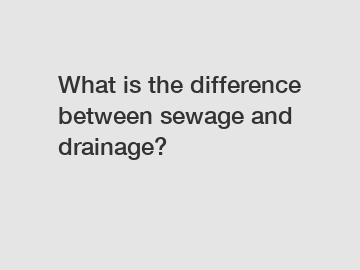What is the difference between sewage and drainage?
What is the difference between sewage and drainage?
Sewage and drainage are two terms related to the disposal and management of water and waste materials. While they may seem similar, there are distinct differences between the two.
Sewage refers to the wastewater generated from homes, businesses, and industries. It consists of water used for various purposes, such as bathing, washing, and toilet flushing, as well as the organic and inorganic waste materials contained in it. Sewage also includes pollutants and chemicals from industrial processes. The management of sewage involves the collection, treatment, and disposal of this wastewater to prevent pollution and protect public health.

On the other hand, drainage refers to the removal of excess water from an area, such as rainwater or groundwater. It involves the construction and maintenance of systems, such as drains, ditches, and gutters, to channel the water away, preventing flooding and water accumulation. Drainage is crucial for ensuring the proper functioning of urban areas, agricultural fields, and infrastructure.
The difference between sewage and drainage lies in the source of the water being managed. Sewage specifically deals with wastewater generated by human activities, while drainage focuses on removing natural water sources, such as rain and groundwater.
The distinction between sewage and drainage is significant as it determines the type of infrastructure and treatment processes required. Sewage management necessitates the development of a comprehensive system that includes sewage pipes, treatment plants, and disposal methods, such as wastewater treatment facilities or septic tanks. It involves sophisticated processes to remove impurities, treat contaminants, and ensure that the released water is safe for the environment.
In contrast, drainage systems primarily involve the construction of drains, gutters, and culverts to redirect excess water away from inhabited areas. While drainage systems may also need treatment measures, such as filtration or sedimentation to remove debris or pollutants, they do not require the extensive facilities and processes involved in sewage management.
The impact and significance of effective sewage and drainage management cannot be underestimated. Proper sewage management is crucial for preventing the spread of diseases, protecting water resources, and maintaining a healthy environment. Inadequate sewage treatment can lead to water pollution, contamination of drinking water sources, and the transmission of waterborne diseases.
Similarly, drainage plays a vital role in urban planning, agriculture, and infrastructure development. Effective drainage systems help prevent flooding, control erosion, and safeguard the foundations of buildings and structures. They improve the quality of life for residents and contribute to sustainable development.
In conclusion, while sewage and drainage both deal with the management of water, they differ in terms of the water source being managed. Sewage focuses on the treatment and disposal of wastewater generated by human activities, while drainage involves the removal of excess natural water. Understanding the difference between sewage and drainage is essential for implementing appropriate infrastructure and treatment measures to ensure water security, public health, and sustainable development.
Want more information on HDPE water pipe, large-diameter internal pipe reinforcement, hdpe pipes for water supply gas or mining? Feel free to contact us.

Comments